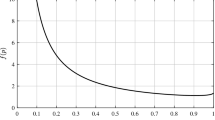Abstract
Markov chain Monte Carlo (MCMC) methods, while facilitating the solution of many complex problems in Bayesian inference, are not currently well adapted to the problem of marginal maximum a posteriori (MMAP) estimation, especially when the number of parameters is large. We present here a simple and novel MCMC strategy, called State-Augmentation for Marginal Estimation (SAME), which leads to MMAP estimates for Bayesian models. We illustrate the simplicity and utility of the approach for missing data interpolation in autoregressive time series and blind deconvolution of impulsive processes.
Similar content being viewed by others
References
Bernardo J.M. and Smith A.F.M. 1994. Bayesian Theory. John Wiley & Sons, New York.
Cappé O., Doucet A., Moulines E., and Lavielle M. 1999. Simulation-based methods for blind maximum-likelihood filter identification. Signal Processing 73: 3-25.
Carter C.K. and Kohn R. 1994. On Gibbs sampling for state space models. Biometrika 81: 541-553.
Celeux G. and Diebolt J. 1985. The SEM algorithm: A probabilistic teacher algorithm derived from the EM algorithm for the mixture problem. Computational Statistics 2: 73-82.
Celeux G. and Diebolt J. 1990. Une Version Recuit Simulé de l'Algorithme EM. Comptes Rendus de l'Académie des Sciences 310: 119-124 (in French).
Cheng Q., Chen R., and Li T. 1996. Simultaneous wavelet estimation and deconvolution of reflection seismic signals via Gibbs sampler.IEEE Transactions on Geoscience and Remote Sensing 34: 377-384.
DeJong P. and Shephard N. 1995. The simulation smoother for time series models. Biometrika 82: 339-350.
Dempster A.P., Laird N.M., and Rubin D.B. 1977. Maximum likelihood from incomplete data via the EM algorithm. Journal of the Royal Statistical Society B 39: 1-38.
Gilks W.R., Richardson S., and Spiegelhalter D.J. 1996. Markov Chain Monte Carlo in Practice. Chapman and Hall, London.
Godsill S.J. and Rayner P.J.W. 1998. Digital Audio Restoration-A Statistical Model-Based Approach. Springer-Verlag, London.
Ripley B.D. 1987. Stochastic Simulation. Wiley, New York.
Robert C.P. 1996. The Bayesian Choice, Springer-Verlag Series in Statistics. Springer-Verlag, New York.
Robert C.P. 1998. Discretization and MCMC Convergence Assessment, Lecture Notes in Statistics no. 135. Springer-Verlag, New York.
Robert C.P. and Casella G. 1999. Monte Carlo Statistical Methods, Springer-Verlag Series in Statistics. Springer-Verlag, New York.
Van Laarhoven P.J. and Arts E.H.L. 1987. Simulated Annealing: Theory and Applications. Reidel, Amsterdam.
Wei G.C.G. and Tanner M.A. 1990. A Monte Carlo implementation of the EMalgorithm and the poor man's data augmentation algorithm. Journal of the American Statistical Association 85: 699-704.
Rights and permissions
About this article
Cite this article
Doucet, A., Godsill, S.J. & Robert, C.P. Marginal maximum a posteriori estimation using Markov chain Monte Carlo. Statistics and Computing 12, 77–84 (2002). https://doi.org/10.1023/A:1013172322619
Issue Date:
DOI: https://doi.org/10.1023/A:1013172322619




